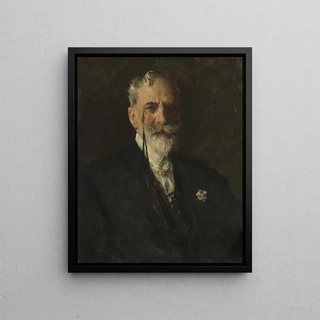Art print | Self-portrait - William Merritt Chase Source: Reproduction | Autoportrait - William Merritt Chase


View from behind

Frame (optional)
William Merritt Chase's Self-Portrait is a work that transcends a simple reflection of the artist. This painting, both intimate and bold, invites viewers to delve into the artist's personal universe while offering a broader view of the 19th-century artistic society. The piece stands out for its striking realism and exploration of the nuances of the human soul, revealing a psychological depth that echoes the quest for identity shared by many artists of his era. In this work, Chase does not merely depict himself; he creates a dialogue between his inner being and the external world, a universal theme that still resonates today.
Style and uniqueness of the work
Chase's Self-Portrait is distinguished by its Impressionist style, characterized by fluid brushstrokes and a palette of vibrant colors. The artist masters light, playing with shadows and reflections, which gives his face an almost tangible liveliness. Every detail, from the piercing gaze to the textures of the clothing, is carefully crafted, demonstrating exceptional skill. Chase manages to capture not only his physical appearance but also the very essence of his personality. The composition is both classic and modern, blending traditional elements with an innovative approach that places him at the forefront of his time. This mixture of techniques and stylistic influences makes this work a perfect example of the evolution of American art at the end of the 19th century.
The artist and his influence
William Merritt Chase, an iconic figure of the American Impressionist movement, knew how to leave his mark on his era with his unique vision and his ability to incorporate European influences into his art. Born in 1849, he trained at the Munich Academy of Fine Arts, where he was exposed to the techniques of European masters, but he also developed a style that was entirely his own. Chase contributed to the rise of Impressionism in the United States by founding the Shinnecock School of Painting, which attracted many artists eager to explore this new approach. His influence is still felt today, as he paved the way for a generation of artists seeking to express their emotions

Matte finish

View from behind

Frame (optional)
William Merritt Chase's Self-Portrait is a work that transcends a simple reflection of the artist. This painting, both intimate and bold, invites viewers to delve into the artist's personal universe while offering a broader view of the 19th-century artistic society. The piece stands out for its striking realism and exploration of the nuances of the human soul, revealing a psychological depth that echoes the quest for identity shared by many artists of his era. In this work, Chase does not merely depict himself; he creates a dialogue between his inner being and the external world, a universal theme that still resonates today.
Style and uniqueness of the work
Chase's Self-Portrait is distinguished by its Impressionist style, characterized by fluid brushstrokes and a palette of vibrant colors. The artist masters light, playing with shadows and reflections, which gives his face an almost tangible liveliness. Every detail, from the piercing gaze to the textures of the clothing, is carefully crafted, demonstrating exceptional skill. Chase manages to capture not only his physical appearance but also the very essence of his personality. The composition is both classic and modern, blending traditional elements with an innovative approach that places him at the forefront of his time. This mixture of techniques and stylistic influences makes this work a perfect example of the evolution of American art at the end of the 19th century.
The artist and his influence
William Merritt Chase, an iconic figure of the American Impressionist movement, knew how to leave his mark on his era with his unique vision and his ability to incorporate European influences into his art. Born in 1849, he trained at the Munich Academy of Fine Arts, where he was exposed to the techniques of European masters, but he also developed a style that was entirely his own. Chase contributed to the rise of Impressionism in the United States by founding the Shinnecock School of Painting, which attracted many artists eager to explore this new approach. His influence is still felt today, as he paved the way for a generation of artists seeking to express their emotions






